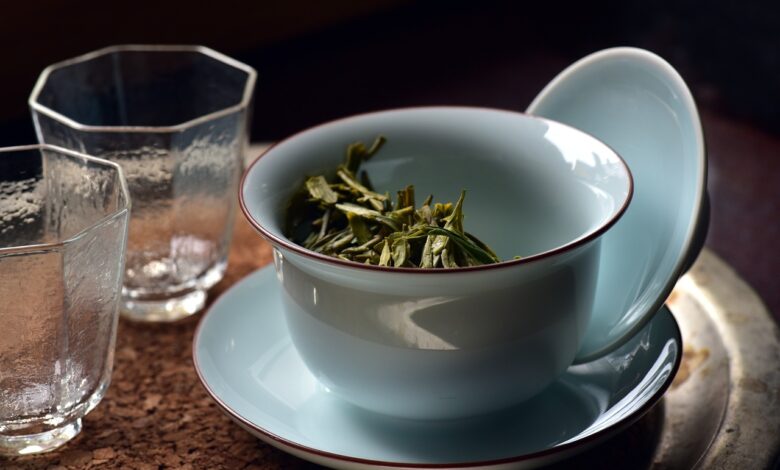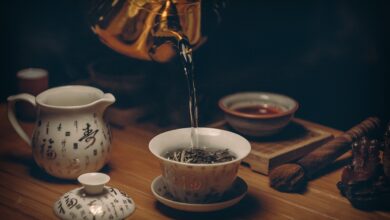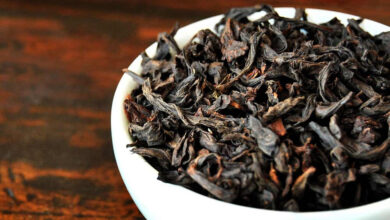
Chinese tea has been an integral part of Chinese culture for thousands of years, revered not only for its delicate flavors but also for its numerous health benefits. This essay will delve into the various types of Chinese tea, their historical significance, and the extensive range of benefits they offer.
Types of Chinese Tea
Chinese tea can be broadly categorized into six main types: green tea, black tea, white tea, oolong tea, yellow tea, and pu-erh tea. Each type undergoes different processing methods, resulting in unique flavors and health benefits.
Green Tea
Green tea is the most well-known type of Chinese tea. It is made from unoxidized leaves and is the least processed type, preserving most of its natural antioxidants and polyphenols. Popular varieties include Longjing (Dragon Well) and Bi Luo Chun.
Black Tea
Black tea, known as “hong cha” in Chinese, is fully oxidized, giving it a dark color and robust flavor. Famous black teas include Keemun and Dianhong. Black tea is known for its rich taste and high caffeine content.
White Tea
White tea is the least processed of all teas, made from young leaves and buds that are simply dried. It has a delicate flavor and is rich in antioxidants. Silver Needle and White Peony are popular white teas.
Oolong Tea
Oolong tea is partially oxidized, placing it between green and black tea in terms of flavor and color. It is known for its complex taste and aroma. Famous oolong teas include Tieguanyin and Da Hong Pao.
Yellow Tea
Yellow tea is similar to green tea but undergoes a slower drying process, which allows the leaves to yellow slightly. This tea is rare and highly prized for its smooth and mellow flavor. Junshan Yinzhen is a notable variety.
Pu-erh Tea
Pu-erh tea is aged and fermented, often improving with age like fine wine. It has a rich, earthy flavor and is prized for its digestive benefits. Pu-erh is categorized into raw (sheng) and ripe (shou) types.
Historical Significance of Chinese Tea
Tea drinking in China dates back to the Shang dynasty (1600–1046 BCE). Initially, tea was consumed for its medicinal properties. Over centuries, tea became an essential part of Chinese social life, symbolizing hospitality and respect.
The Tang dynasty (618–907 CE) marked a golden age for tea, where it became a common beverage, and the tea culture flourished. The famous book “The Classic of Tea” by Lu Yu, written during this period, laid the foundation for the art of tea drinking.
The Song dynasty (960–1279 CE) saw further developments in tea culture, including the advent of powdered tea, which influenced the Japanese tea ceremony. The Ming dynasty (1368–1644 CE) introduced loose-leaf tea, which remains popular today.
Health Benefits of Chinese Tea
Chinese tea is not only a cultural cornerstone but also a powerhouse of health benefits. Here are some of the key benefits associated with different types of Chinese tea:
Rich in Antioxidants
Most Chinese teas are rich in antioxidants, particularly catechins and polyphenols. These compounds help neutralize harmful free radicals in the body, reducing oxidative stress and lowering the risk of chronic diseases such as cancer and heart disease.
Enhances Metabolism and Aids in Weight Loss
Green tea and oolong tea are particularly known for their metabolism-boosting properties. The catechins in green tea and the polyphenols in oolong tea can enhance fat oxidation and improve weight loss when combined with a healthy diet and exercise.
Supports Heart Health
Regular consumption of Chinese tea can improve cardiovascular health. The flavonoids in tea help reduce bad cholesterol (LDL) levels, improve blood vessel function, and lower blood pressure, reducing the risk of heart disease and stroke.
Improves Mental Alertness
The caffeine and amino acid L-theanine found in many Chinese teas work synergistically to enhance brain function. They can improve alertness, concentration, and mood without causing the jitteriness often associated with other caffeinated beverages.
Aids Digestion
Pu-erh tea is renowned for its digestive benefits. It can help break down fats, aid in digestion, and improve gut health. This makes it an excellent post-meal beverage.
Enhances Immune Function
The antioxidants and vitamins in Chinese tea, such as vitamin C, can boost the immune system. Regular tea consumption helps the body fight off infections and illnesses more effectively.
Reduces Stress and Promotes Relaxation
The ritual of brewing and drinking tea itself can be a meditative practice, promoting relaxation and reducing stress. The L-theanine in tea also has calming effects on the mind.
Chinese tea is more than just a beverage; it is a cultural heritage with profound health benefits. Whether you prefer the delicate notes of green tea, the robust flavor of black tea, or the earthy richness of pu-erh, incorporating Chinese tea into your daily routine can enhance your health and well-being. The centuries-old tradition of tea drinking continues to thrive, bringing both enjoyment and numerous health advantages to tea lovers around the world.



